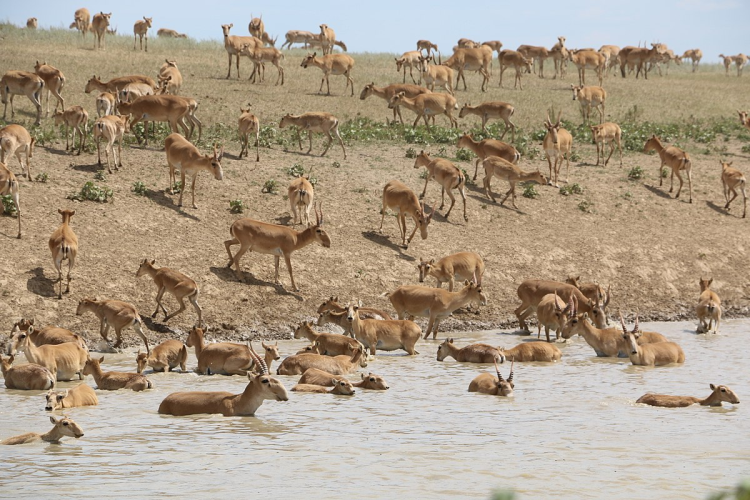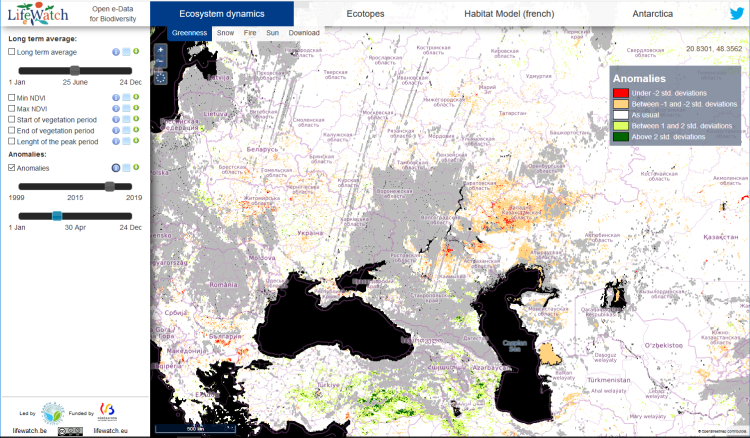You are here
Understanding mass mortality in saiga antelope population
The Saiga antelope is an endangered species that lives in Central Asian steppes and semi-arid regions. Scientists around the world are working tirelessly to prevent it from becoming completely extinct. Every year, they migrate approximately 500 km from north to south, and back. In 2015, roughly 60% of the population of antelopes died in just a few days. Analysis revealed the presence of a bacteria, but it was not enough to justify the low survival rate (10%). Many different experts therefore combined their expertise to understand the phenomenon, including the analysis of LifeWatch satellite time series. Based on the analysis of previous disasters, the researchers realized that humid and hot weather led to the widespread illness. On the other hand, the study highlighted the need for multidisciplinary approach to research mass mortality events under rapid environmental change.
Keywords: saiga, multidisciplinary, satellite time series, mass mortality, Pasteurella multocida
Professor Richard Kock
Background
The saiga antelope is a critically endangered antelope. It is the only species of antelope that lives in Eurasia. Its prominent feature is the pair of closely spaced, bloated nostrils directed downward. According to Wikipedia, it originally inhabited a vast area of the Eurasian steppe zone from the foothills of the Carpathian Mountains and Caucasus into Dzungaria and Mongolia. After suffering poaching and environmental threats, the dominant subspecies (S. t. tatarica) is only found in one location in Russia and three areas in Kazakhstan.
In 2015, more than 200,000 saiga antelopes died in 3 weeks in central Kazakhstan. The proximate cause of death was confirmed as hemorrhagic septicemia caused by the bacterium Pasteurella multocida type B, based on multiple strands of evidence. However, the reason why this usually harmless bacteria became toxic was unknown. A group of researchers led by Pr R. Kock therefore joined forces to solve this mystery. This team included scientists from different fields, including veterinary, biology, epidemiology and remote sensing.
Methodology
This research was conducted as part of a wide international collaboration, adopting a 'One Health' approach – looking at the wildlife, livestock, environmental and human impacts that have driven disease emergence in saiga populations. Adopting such a holistic approach has enabled the research team to understand the wider significance of die-offs in saiga populations, beyond simply the proximate causes of the 2015 epidemic.
The environmental conditions of the past 20 years were analyzed to identify the favoring factors of the opportunistic bacterial infection in the past. Time series of meteorological variables and land surface dynamics variables provided by LifeWatch were therefore analyzed. The statistical analysis of those datasets highlighted the importance of warm and humid meteorological conditions on the mass mortality events.
Used components of the LifeWatch Infrastructure
Land cover dynamics website
The land cover dynamics website is one of the contributions of the Fédération Wallonie-Bruxelles to the LifeWatch ERIC. It was initiated in 2015 to distribute curated remotely sensed time series about key observable variables of the terrestrial environment in Europe. The first variable is about snow cover. The weekly snow cover probability is provided alongside key temporal metric. Near-real time anomalies (unusual presence or absence of snow cover in a given region) then give a snapshot of the snow cover status in Europe every week. The second variable of interest is the vegetation greenness. This information is derived from the normalized vegetation index, which is sensitive to photosynthetically active vegetation. Similar to the case of snow cover, long term average, temporal metrics and weekly anomalies are provided.
Output
Publications
News
- Death on the Steppes: Mystery Disease Kills Saigas (The New York Times, May 29, 2015)
- Mass deaths of saiga antelope in Kazakhstan caused by bacteria (The Guardian, April 14, 2016)
- Why Did Two-Thirds of These Weird Antelope Suddenly Drop Dead? (The Atlantic, January 17, 2018)
- Saigas on the Brink: Mass Mortality Event caused by Climate (Lonely Creatures, January 18, 2018)
- 'Climate envelope' responsible for mass deaths of Saiga antelopes (Digital Journal, January 18, 2018)
- Scientists uncover secret of mass antelope mortality event in remote steppe grassland of Central Asia (Phys.Org, January 18, 2018)
- Scientists uncover why 200,000 antelope suddenly died (Oxford Science Blog, January 19, 2018)
- Qu’est-ce qui a tué les antilopes saïgas? (UCLouvain Science Today, March 20, 2018)
- Death on the steppes: The saga of the saiga antelope (Animalogic, November 12, 2018)
- Saiga Struggling to Survive (All Creatures Podcast Episode 81, April 2, 2019)
- The Saiga Antelope: A Species on the Brink of Extinction (Mu Animals, April 25, 2019)
Contact
E-mail: julien.radoux@uclouvain.be
Useful links
Land Cover Dynamics Website: http://maps.elie.ucl.ac.be/lifewatch/geoviewer.html
Image credits
- Dead Saiga antelope, Sergei Khomenko (FAO)
- Saiga in West Kazakhstan. Author: Yakov Fedorov [CC BY-SA 4.0 (https://creativecommons.org/licenses/by-sa/4.0)], via Wikimedia Commons
- Wild saiga antelope, Saiga tatarica tatarica visiting a waterhole at the Stepnoi Sanctuary, Astrakhan Oblast, Russia. Author: Andrey Giljov [CC BY-SA 4.0 (https://creativecommons.org/licenses/by-sa/4.0)], via Wikimedia Commons




